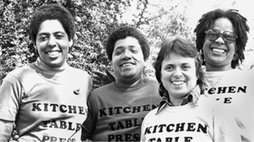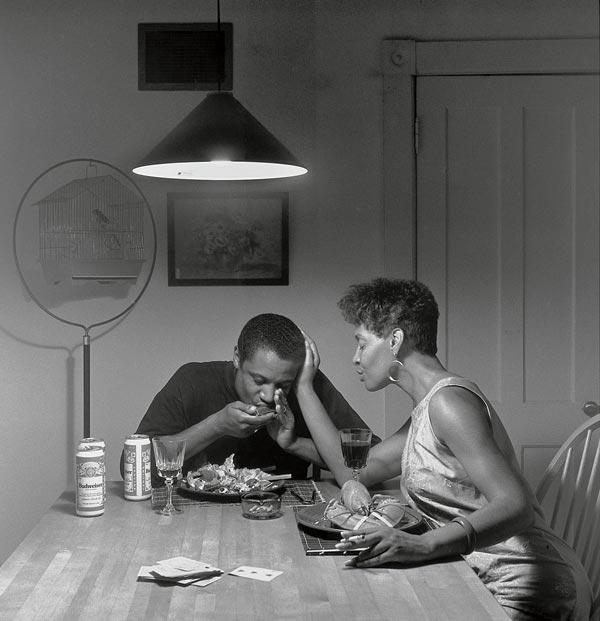The “Black Sexism Debate” issue of The Black Scholar, Vol. 10, No. 8/9, May/June 1979, reminded me of Nikki Giovanni’s remarkable 1971 dialogue with James Baldwin on Soul!, a TV program that has been called the U.S.’s “first Black Tonight Show.”
While host Ellis Haizlip introduces James Baldwin as “Mr. Baldwin,” he introduces Giovanni as “Nikki.” The dynamic between Baldwin and Giovanni is compelling. At times, when Baldwin calls Giovanni “baby, baby, baby,” and “my dear,” it comes across as approachable; at other times, it comes across as rather patronizing. (Affectionately, and perhaps wryly, she responds by calling him “Jimmy.”) He routinely interrupts and corrects her, blurring the line between his status as an elder and his status as a man.
At one point (51:00), while Giovanni struggles to get a word in about Black women and children’s experiences with domestic violence and lack of support from Black men, Baldwin puts his hand over hers, stopping her hand gestures, and says, “But wait, wait, hold the phone, hold the phone, hold the phone, hold the phone, baby.” He gives her hand a squeeze before gesturing towards himself. “Look,” he transitions, “I’ve had to learn in my own life…” Divested by racism of the social economic ability to provide for his family, Baldwin suggests, “I’m no longer in my own eyes – it doesn’t make any difference what you may think of me – in my own eyes I’m not a man.” Giovanni does not budge, responding at once, “It does indeed make a difference what I think about it.”
Earlier, Giovanni has explained her position (48:11):
Let’s say a guy’s going with a girl. You’re going with Maybelle and Maybelle gets pregnant, and all of a sudden you can’t speak to Maybelle because you don’t have the money for a crib, right? Maybelle doesn’t need a crib. […] What Maybelle needs at that moment is a man. […] A man […] is not necessarily a provider of all that stuff. […] You don’t have a job. […] Maybelle understands there is no job. But what she needs is a man to come by and say, ‘Hey baby, you look good.’ And Black men refuse to function like that because they say, ‘I want to bring the crib when I come.’ You’re never going to get the crib. Bring yourself. […] I’m a poor woman. […] I’m already deprived of almost everything that we find in the world. Must I also be deprived of you?
Baldwin responds with a memorable quote (50:16): “You can blame him [the man] on a human level if you like, but I think it’s more interesting to try to – you have to understand it, the bag the cat is in.” His riff on the saying is powerful, but where do Black women fit in? Are Black women responsible for understanding both the social reality men have been stuffed into, and their own? Are men and women’s “bags” separate at all? And if there are two cats in one bag, can they not use their combined strength to discover the shape of their social reality together, to break out together? Why is it an inevitability for the bag to be external to the man, to overdetermine the man’s behavior, and yet an expectation for the woman to understand the bag and accommodate its harmful effects on people trapped inside? Why are women expected to perform unique epistemological labor to understand social realities affecting multiple genders?
The question of how Black men can better understand and support Black women’s struggle against oppression never comes up in Giovanni and Baldwin’s dialogue. I was reminded of Erykah Badu’s “Bag Lady”:
Bag lady you gone hurt your back
Dragging all them bags like that
I guess nobody ever told you
All you must hold onto, is you, is you, is you
This resonates with Giovanni’s insistence: “You’re never going to get the crib. Bring yourself.” Whereas Baldwin emphasizes a man’s dependence on the bag in which he has been trapped, and thus “the Black man’s” need to be seen as a man by white society’s standards, Giovanni focuses on “Maybelle’s” radical antimaterialist love for her man. He is already seen as a man by the woman right in front of him; if only he would value her perspective just as much as his own, she wouldn’t pay the price of his needing affirmation elsewhere. As Toni Morrison critiqued Ralph Ellison’s Invisible Man – “Invisible to whom?”
There is no unmediated relationship, Giovanni and Morrison suggest, between “the Black man” and a larger, uniformly white “society.” Relationships between Black people and their world are also shaped by families, communities, and workplaces in which Black women and Black men can and must support each other, across difference. A Black woman’s perspective is essential to establish this radical commons. Otherwise, Black women become, as Donna Kate Rushin has written so eloquently in Bridge Poem (1981), the bridge between Black men and white society. Who will build Black women’s healing connections to each other, and to themselves? As Audre Lorde challenges, “If society ascribes roles to black men which they are not allowed to fulfill, is it black women who must bend and alter our lives to compensate, or is it society that needs changing?” (The Black Scholar, “The Black Sexism Debate,” 17).
Like Giovanni’s Maybelle, June Jordan uses the Scholar‘s conversation around sexism to advance an anticapitalist argument. “The point is not whether he earns a couple dollars more or less than she; the point is that, as a people, our ability to provide for ourselves is under […] white institutional attack,” Jordan stresses (The Black Scholar, “The Black Sexism Debate,” 40). Aspiring to gendered white economic ideals and competing for scraps will not fix this crisis; rather, solidarity and Lorde’s “Uses of the Erotic” are in order. The ideal man for Giovanni’s Maybelle refuses to buy into the demands of racist capitalist materialism, for he does not measure his worth in dollars or property accumulation. He brings value to Maybelle’s life in himself, by offering to share emotional support and child care responsibilities, and by treating her with respect. He carries his own weight, and they are both freer for it.
[1] Quentin Lucas has written an excellent analysis of their conversation, with excerpts transcribed, for Medium.



